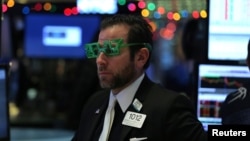U.S. stocks ended the last trading day of 2016 on a down note, although solidly up on the year. Since the low point on February 11, the markets have made a massive turnaround.
Coming into Friday, the Standard & Poor's 500 index was up about 6 percent since the U.S. general election on November 8 and up 11 percent for the year, while the Nasdaq Composite index gained 9.6 percent. The Dow Jones Industrial Average, ever flirting with 20,000, is up almost 9 percent since the election, bringing its year-to-date gain to nearly 14 percent.
"It was a year characterized by turnarounds, where previous laggards asserted themselves as market leaders," Katie Stockton, chief technical strategist at BTIG Research, said in a note. "This was particularly evident in value versus growth, and in the energy and financial sectors, which are the top performers year to date."
Stocks have enjoyed a "Trump bump" since the presidential election on bets that President-elect Donald Trump will introduce tax cuts, deregulation and higher infrastructure spending that would spur economic growth.
Commodity rally
Crude oil slipped 0.3 percent to $53.61 a barrel, after Thursday's 0.5 percent decline. Prices are up about 45 percent this year, after crashing below the $27 level on February 11. Supply cuts from the OPEC nations and other oil producers next month are intended to stabilize the market and reduce the oil glut.
Gold fell 0.3 percent to $1,155.07 an ounce after rising for four days. The metal is up about 9 percent for the year. Copper, a metal used to measure industrial strength, reached an all-time high of $260.55 in December.
U.S. dollar
The U.S. dollar hit a 14-year high against the euro recently, and the dollar index is up 7.5 percent for the fourth quarter. Typically, a rising dollar is thought to handicap U.S. industries because it hurts exporters, but it could be a bonus for consumers.
"U.S. consumers can buy more goods with their stronger currency. And since consumption makes up roughly 70 percent of gross domestic product," said Hedgeye senior macro analyst Darius Dale, "when the dollar is strengthening, American consumers get a boost and so, too, does the U.S. economy."
Trading week ahead
While this is a short week for traders with Monday closed for the New Year's Day holiday, several events bear watching. There will be a few key earnings reports, including Monsanto, Constellation Brands and Walgreens. In addition, the Consumer Electronics Show is set for January 5-8 in Las Vegas, and that always has a tendency to move tech stocks. TV, cars, phones and virtual reality are expected to be the hot topics at 2017's show, so watch stocks like Apple, Tesla and NVIDIA, among others.
2017 outlook
In the near term, some analysts expect that there will be some selling in January as investors have been waiting to take gains in 2017 because of Trump's anticipated tax cuts, but in the longer term, the narrative appears to be bullish.
"In 2016, financial markets, the economy and geopolitics experienced an unusual number of milestones," analysts at LPL Research said. "The approach for 2017 will be to assess how these milestones — the stabilization of oil, the end of an earnings recession and a new president — have come together to influence the investment landscape."
The firm believes the following three themes may influence investment success in 2017:
— A smoother path to policy changes. A Republican president working with a Republican Congress should clear the way for implementing policy changes.
— A return to earnings growth. Earnings growth may be supported by an accelerating U.S. economy, rebounding energy sector profits as oil prices stabilize, and steady profit margins.
— The dual mandate dynamic. Federal Reserve policy is driven by the dual mandate of keeping inflation low and the economy near maximum employment, which may look different in 2017 as the labor market approaches full employment and inflationary pressures increase.
"Our outlook remains bullish on global equities, and we are looking for stabilization in international markets versus the U.S. We believe Treasury yields will work their way gradually higher, and the U.S. dollar should remain strong," Stockton said. "Commodity prices are likely to remain mixed, with spots of strength and weakness."








